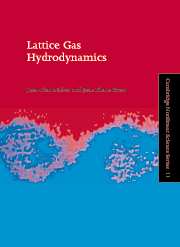Book contents
- Frontmatter
- Contents
- Preface
- Chapter 1 Basic ideas
- Chapter 2 Microdynamics: general formalism
- Chapter 3 Microdynamics: various examples
- Chapter 4 Equilibrium statistical mechanics
- Chapter 5 Macrodynamics: Chapman–Enskog method
- Chapter 6 Linearized hydrodynamics
- Chapter 7 Hydrodynamic fluctuations
- Chapter 8 Macrodynamics: projectors approach
- Chapter 9 Hydrodynamic regimes
- Chapter 10 Lattice gas simulations
- Chapter 11 Guide for further reading
- Appendix Mathematical details
- References
- Author index
- Subject index
Chapter 5 - Macrodynamics: Chapman–Enskog method
Published online by Cambridge University Press: 13 October 2009
- Frontmatter
- Contents
- Preface
- Chapter 1 Basic ideas
- Chapter 2 Microdynamics: general formalism
- Chapter 3 Microdynamics: various examples
- Chapter 4 Equilibrium statistical mechanics
- Chapter 5 Macrodynamics: Chapman–Enskog method
- Chapter 6 Linearized hydrodynamics
- Chapter 7 Hydrodynamic fluctuations
- Chapter 8 Macrodynamics: projectors approach
- Chapter 9 Hydrodynamic regimes
- Chapter 10 Lattice gas simulations
- Chapter 11 Guide for further reading
- Appendix Mathematical details
- References
- Author index
- Subject index
Summary
In Chapter 4, we gave a statistical mechanical analysis of lattice gases, and discussed the equilibrium properties; we described uniform uncorrelated statistical equilibria, and we showed that they have a Fermi–Dirac probability distribution. The existence of these uniform equilibrium solutions can be established without recourse to the Boltzmann approximation; the only required conditions are the semi-detailed balance and the existence of local invariants. These equilibrium solutions – the analogue of global equilibria in usual statistical mechanics – are uniform by construction: the macroscopic variables, i.e. the ensemble-averages of the local invariants, are space-and time-independent.
Now, we address the problem of space-and time-varying macrostates in the ‘hydrodynamic limit’, that is, macrostates for which macroscopic variables vary over space and time scales much larger than the characteristic microscopic scales (lattice spacing and time-step duration). This scale separation between microscopic and macroscopic variables is a crucial physical ingredient in the theory of lattice gas hydrodynamic equations, and it is at the core of the forthcoming derivation, which rests upon a discrete version of the well-known ‘Chapman–Enskog method’ (see Chapman and Cowling, 1970).
Although the principles of the method described hereafter apply to a wider class of models, we are led, at a certain point of the forthcoming algebraic procedure, to particularize our study to the (still wide) class of ‘single-species thermal models’ defined in Chapter 4, Section 4.5.2. The simpler case of nonthermal models is also treated, but in a less detailed manner (see Section 5.7).
- Type
- Chapter
- Information
- Lattice Gas Hydrodynamics , pp. 109 - 136Publisher: Cambridge University PressPrint publication year: 2001



